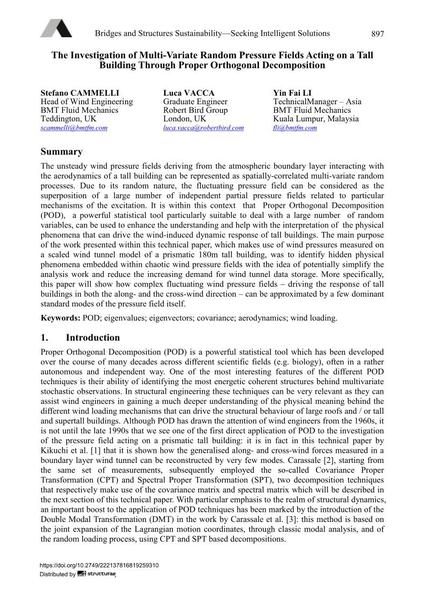The Investigation of Multi-Variate Random Pressure Fields Acting on a Tall Building Through Proper Orthogonal Decomposition

|
|
|||||||||||
Détails bibliographiques
| Auteur(s): |
Stefano Cammelli
Luca Vacca Yin Fai Li |
||||
|---|---|---|---|---|---|
| Médium: | papier de conférence | ||||
| Langue(s): | anglais | ||||
| Conférence: | IABSE Conference: Bridges and Structures Sustainability - Seeking Intelligent Solutions, Guangzhou, China, 8-11 May 2016 | ||||
| Publié dans: | IABSE Conference, Guangzhou, China, 8 – 11 May 2016 | ||||
|
|||||
| Page(s): | 897-904 | ||||
| Nombre total de pages (du PDF): | 8 | ||||
| Année: | 2016 | ||||
| DOI: | 10.2749/222137816819259310 | ||||
| Abstrait: |
The unsteady wind pressure fields deriving from the atmospheric boundary layer interacting with the aerodynamics of a tall building can be represented as spatially-correlated multi-variate random processes. Due to its random nature, the fluctuating pressure field can be considered as the superposition of a large number of independent partial pressure fields related to particular mechanisms of the excitation. It is within this context that Proper Orthogonal Decomposition (POD), a powerful statistical tool particularly suitable to deal with a large number of random variables, can be used to enhance the understanding and help with the interpretation of the physical phenomena that can drive the wind-induced dynamic response of tall buildings. The main purpose of the work presented within this technical paper, which makes use of wind pressures measured on a scaled wind tunnel model of a prismatic 180m tall building, was to identify hidden physical phenomena embedded within chaotic wind pressure fields with the idea of potentially simplify the analysis work and reduce the increasing demand for wind tunnel data storage. More specifically, this paper will show how complex fluctuating wind pressure fields – driving the response of tall buildings in both the along- and the cross-wind direction – can be approximated by a few dominant standard modes of the pressure field itself. |
||||
